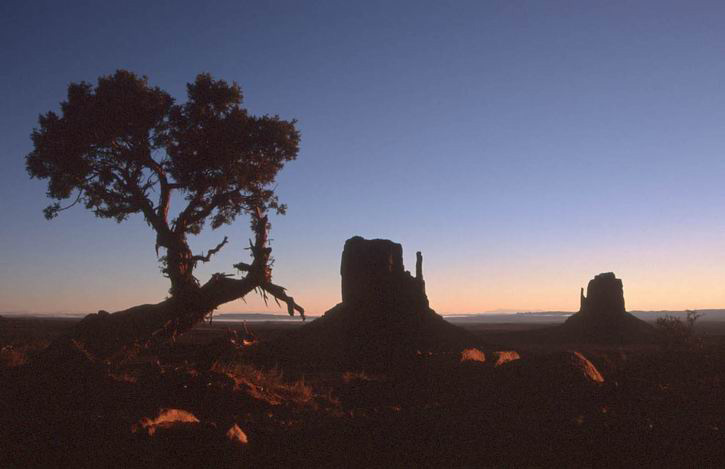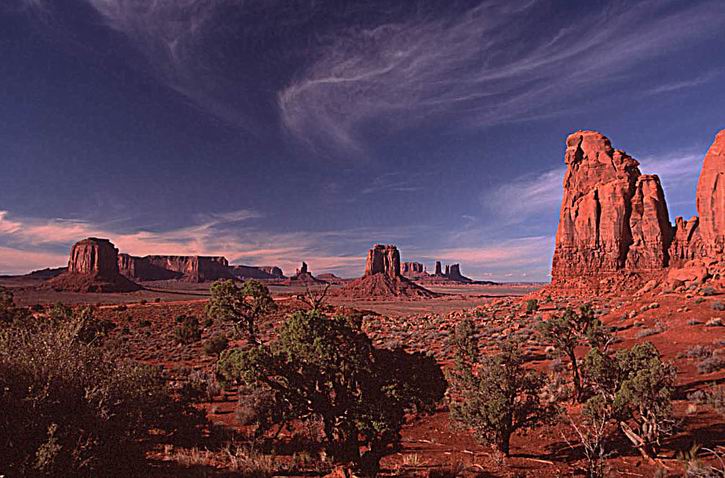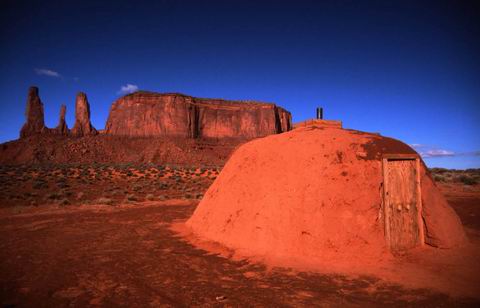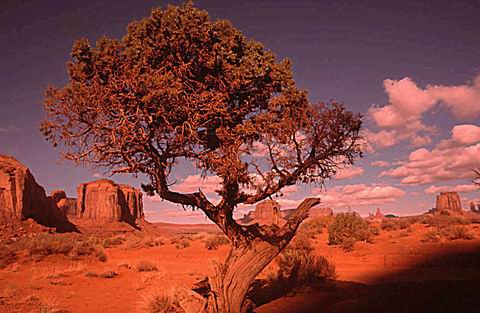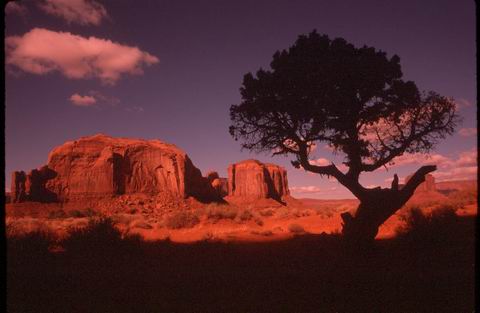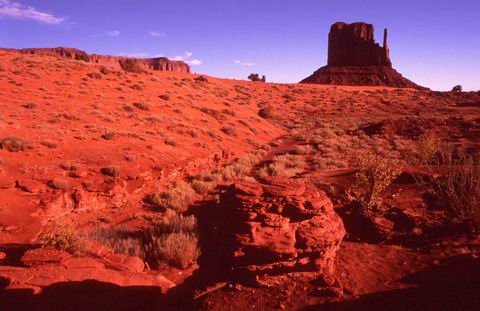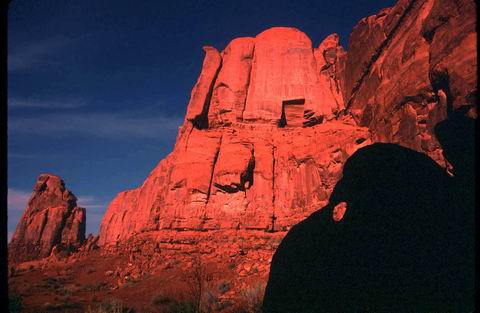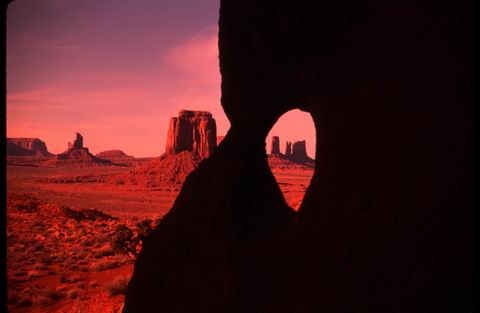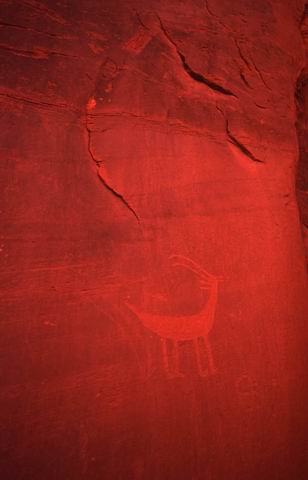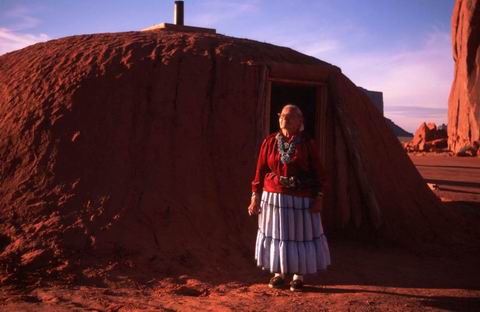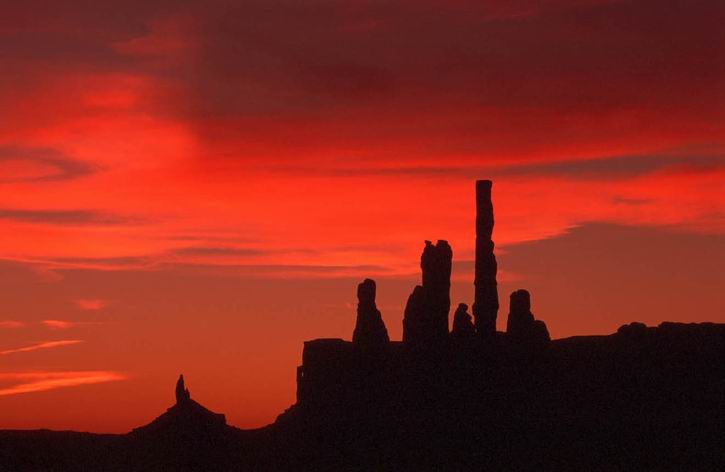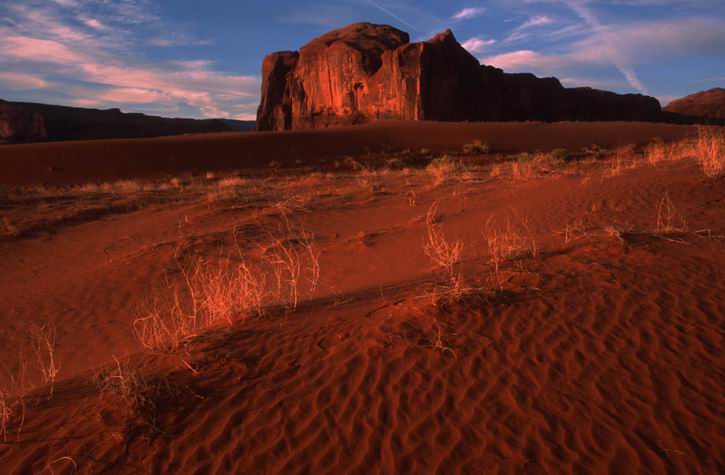|
MONUMENT VALLEY
Sacred Land of The DINEH
by Jim Moerschel
As the sun rose on my first morning in MONUMENT VALLEY, I was very impressed by the spaciousness of this immense, arid, yet overwhelmingly scenic land. My first view was from Mitten View visitor center and as the dawning light beamed its magic upon the landscape, I was awe-struck. This is primarily "wide angle" country and I found myself composing many scenes with my 24 - 70mm zoom, set at 24mm. In many instances I opted for my 20mm for more dramatic panorama. I used the wide angle lens in every way conceivable, to create compositions. At times I found my self lying on the ground, focusing on small subjects in the foreground with the expansive, sandstone cliffs as a background. Then, I might be lying on my back beneath a ledge to gain an unusual perspective of the towering cliffs against a beautiful blue sky. In many cases the great panoramic views are very straightforward, but the scenes can be dramatically altered by taking unusual angles of view as well as using all the focal lengths in a creative manner.
My telephoto zoom (100 - 300) was also used in many situations, primarily to "reach" inaccessible places, but was a great tool to create many "abstract" images by compressing some unusual rock formations against an equally unusual distant cliff. By using the various focal length lenses in an imaginative way, allows the photographer to create a seemingly endless array of images in this photographer's paradise. Monument Valley is not a National Park. It is a Tribal Park, located on the Navajo Reservation, where for centuries, their ancestors lived in this spectacular region. The Navajo call themselves "Dineh" meaning The People, and to them this valley is a sacred place, where their forefathers lived and died with their rich heritage and culture secured in the hidden recesses of red rock canyons. There are several remote places that the Navajo guides will take the visitor to see and photograph. These include ancient ruins, rock art, hogans and of course more spectacular scenic wonders. It is from the Mitten View Visitor Center that the loop road begins. Right after sunrise, the gate swings open and we are off to explore. Visitors are required to keep their vehicles on the unpaved, bumpy loop road. A Navajo guide is required to take you on the excursions into the restricted back country.
The loop road is fine for an introduction to the valley and there are several parking areas that are well marked for taking scenic views. Believe me, there are plenty of locations along the loop road to keep the serious landscape photographer busy all day. However, the big drawback is that the gate is not opened until sunrise for those not led by a guide. So, it is not possible to gain the angle of view of a favored landscape subject until after the "sweet" light is over. The loop road is easily traveled in a conventional car as long as the driver is careful of ruts, wet spots and keeps the speed down. The restricted roads are very bumpy, with deep ruts, small streams and slick washes that require a guide with four wheeled drive vehicles. Once I made the trip around the loop road a few times, I was ready for an in-depth view. To really see the wonders of this land, it is necessary to find a guide. They are located right near the entrance gate at the Visitor Center. There are several booths with different Navajo owned companies, each with their own vehicle, itinerary and driver/guides. Prices vary, according to how long the trip will last, where they will take you and any amenities the company will include. It is best to check as many as you can and make an educated decision.
Harry Goulding and his devoted wife, "Mike" established a trading post around 1920, located only 4 miles from where the new visitor center now stands. Harry convinced movie producer, John Ford to visit and use Monument Valley as the scenic location for a new movie. Since then, "Hollywood" has made countless movies, TV shows and commercials in this timeless landscape. For the next 3 days I hired a guide and visited different locales each day. The guides took me to ancient ruins, ancient rock art and many unusual rock formations with "holes" through them. This really made my creative juices flow and instead of just concentrating on the more traditional landscape photos, I was compelled to compose plenty of abstract images.
To get these unusual shots, I had to do some climbing and scrambling up sandstone ledges to get the proper angle and this gave me the sense of exploration and the spirit of adventure. One abstract led to another and sometimes I found myself wandering a hundred yards from our vehicle, over the dunes, mesmerized by the wealth of photogenic subject matter - all of which was fascinating to view through the lens. One of the great experiences the traveler can have is to meet some of the Navajo people. Our guides took us to the hogan of Suzi Yassi, who is the matriarch of The Bitterwater Clan. For a nominal fee, she will pose in front of her hogan dressed as always, in her traditional garments. I feel most fortunate to have had the opportunity to meet and photograph her. Many of the Navajo people are very gifted artists. Their rugs are world renowned, their beadwork precise and their jewelry superb. Many are fine potters, creating distinctive and original designs. We met Gary Holiday at one of the booths near the visitor center and watched him create his authentic reproductions of Native American implements. Gary's artistic work is sold throughout stores and trading posts in the southwest.
My wife, Lorraine and I planned a trip to photograph the rock formation known as Yei Bi Chei and the Totem Pole. It is best photographed at sunrise when the light will cast dramatic shadows across the nearby sand dunes. We teamed up with Beth Russell, a photographer from Tucson and planned to meet at the visitor center. We met the guide long before first light. The drive would take over half an hour to get in position for our photographs and getting there was quite an adventure. The guide traversed dried river beds, ravines, sand dunes and slick rock in total darkness and finally we arrived near our subject. We walked over the slope of the dune, picked a spot and waited for first light. The silence was deafening. At first no one spoke at all as we set up tripods, selected a lens and began to compose the scene. As we waited, there was total silence throughout the valley. Then, a gentle breeze brushed our hair and stirred the sand - a sign that first light was almost upon us. Then suddenly, a glow appeared behind Yei Bi Chei and we were blessed with beautiful clouds in the colorful sky. Each of us began to speak, but in whispers, as if no one wished to diminish the serenity of this special place. But the spiritual silence was broken by the clicking shutters of our cameras. The light kept changing very quickly and after a few frames of a particular scene, I moved to another spot on the dune, recomposed and fired away. The entire sky was glowing now and I finished photographing Yei Bi Chei.
However, we weren't finished quite yet. All we had to do was turn to either side or behind us and the light show was awesome. Through the years of photographing in the southwestern deserts, I have learned that the first rays of light, illuminate canyon walls, rock spires and mountain peaks in progression - a virtual symphony of light. And here in Monument Valley, that light was beaming and glowing off the canyon walls as one of the most intense red shades I have ever seen. I composed one scene after another. The light was moving and changing in intensity so rapidly, that I barely had time to run across the dune to another spot, set up the tripod, compose and shoot. after only 5 or 10 minutes the sun was up just enough that the "sweet light" was over for now. Sunset would bring it back again.
With the light show over, we began to pack up our camera gear. We were about a half mile from our vehicle and as we walked across the dunes, we seemed once again caught up in the silence of this spiritual place. As we walked in voiceless reverence, it was very easy to visualize in my mind's eye, a lone Navajo, proudly riding his magnificent horse across a distant mesa, seemingly free as the wind, then vanishing into a slot canyon - merely an apparition of my mind. The sacred Yei Bi Chei stirs the creative soul and romantic spirit of those who tread upon the dunes at dawn. It has always been that way in the timeless land called Monument Valley - the sacred land of The Dineh. I wish you good luck in your image making and may all your visions be photogenic.
|
